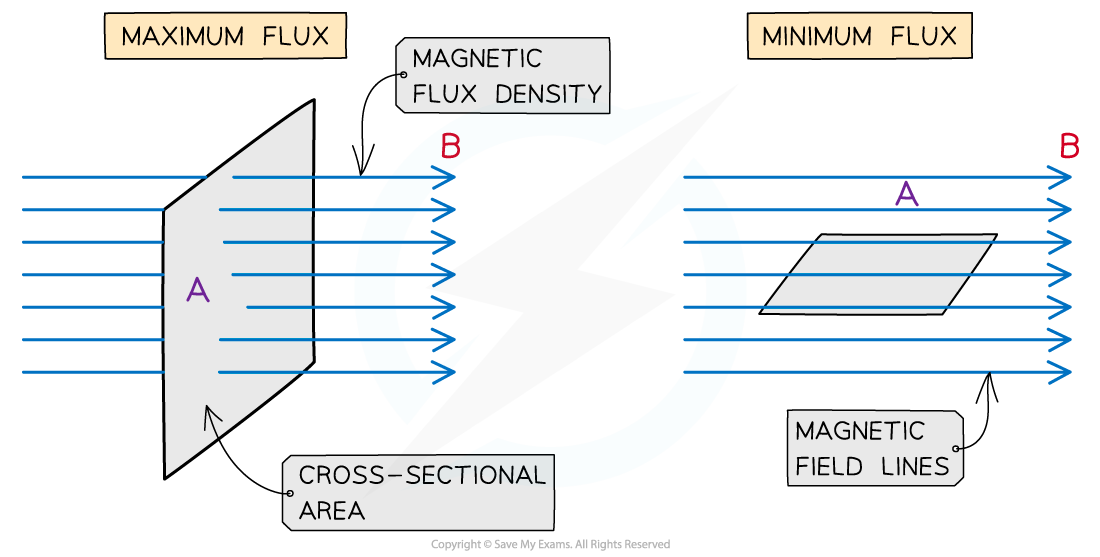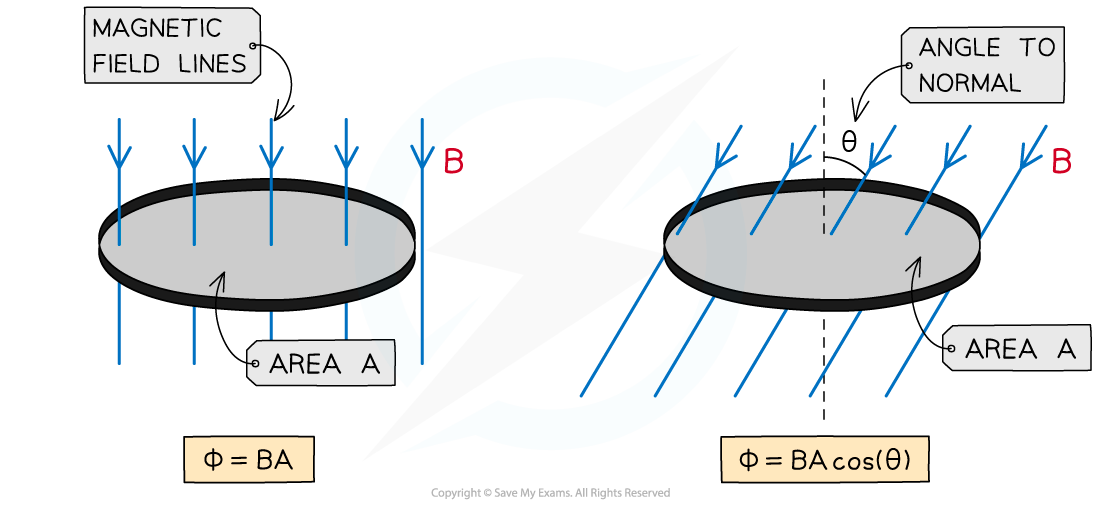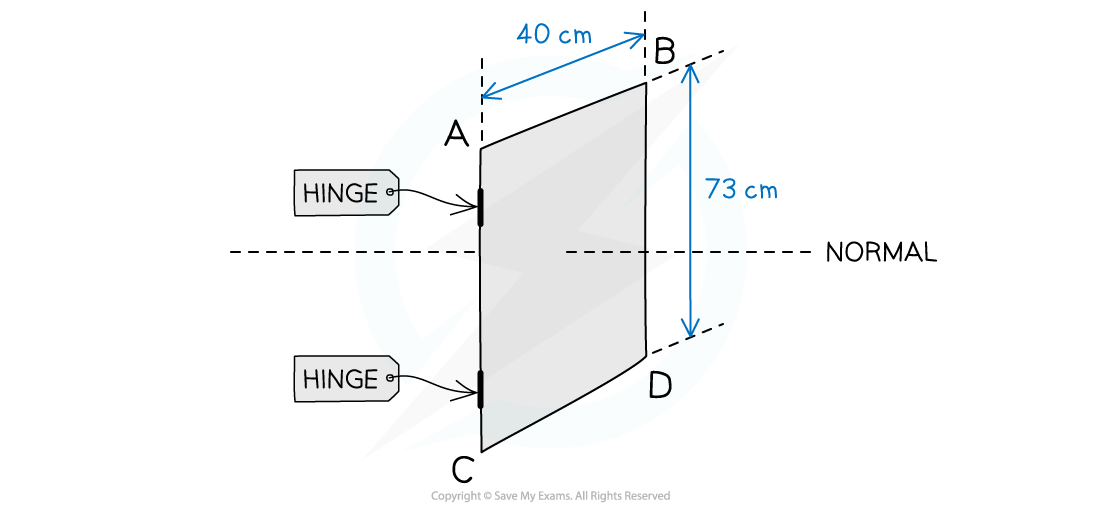Magnetic Flux Density, Flux & Flux Linkage (Edexcel International A Level (IAL) Physics): Revision Note
Exam code: YPH11
Magnetic Flux, Flux Density & Flux Linkage
Magnetic Flux Density
The strength of a magnetic field is defined by the density of the magnetic field lines, or magnetic flux density, at that point
Magnetic flux density is defined by the symbol B
It is measured in Tesla (T)
Rearranging the equation for magnetic force on a wire, the magnetic flux density is defined by the equation:

Where:
B = magnetic flux density (T)
F = magnetic force on a current-carrying wire (N)
I = current (A)
L = length of the wire (m)
For reference, the Earth's magnetic flux density is around 0.032 mT and an ordinary fridge magnet is around 5 mT
The magnetic flux density is sometimes referred to as the magnetic field strength
Magnetic Flux
Magnetic flux is a quantity which signifies how much of a magnetic field passes perpendicularly through some area
For example, the amount of magnetic flux through a rotating coil will vary as the coil rotates in the magnetic field
It is a maximum when the magnetic field lines are perpendicular to the coil area
It is at a minimum when the magnetic field lines are parallel to the coil area
The magnetic flux is defined as:
The product of the magnetic flux density and the cross-sectional area perpendicular to the direction of the magnetic flux density
Magnetic flux is defined by the symbol Φ (greek letter ‘phi’)
It is measured in units of Webers (Wb)
Magnetic flux can be calculated using the equation:
Φ = BA
Where:
Φ = magnetic flux (Wb)
B = magnetic flux density (T)
A = cross-sectional area (m2)

The magnetic flux is maximised when the magnetic field lines and the area through which they are passing through are perpendicular
When magnetic flux is not completely perpendicular to the area A, then the component of magnetic flux density B perpendicular to the area is taken
The equation then becomes:
Φ = BA cos(θ)
Where:
θ = angle between magnetic field lines and the line perpendicular to the plane of the area (often called the normal line) (degrees)

The magnetic flux increases as the angle between the field lines and the normal decreases
This means the magnetic flux is:
Maximum = BA when cos(θ) =1 therefore θ = 0o. The magnetic field lines are perpendicular to the plane of the area
Minimum = 0 when cos(θ) = 0 therefore θ = 90o. The magnetic fields lines are parallel to the plane of the area
An e.m.f is induced in a circuit when the magnetic flux linkage changes with respect to time
This means an e.m.f is induced when there is:
A changing magnetic flux density B
A changing cross-sectional area A
A change in angle θ
Magnetic Flux Linkage
The magnetic flux linkage is a quantity commonly used for solenoids which are made of N turns of wire
The flux linkage is defined as:
The product of the magnetic flux and the number of turns of the coil
It is calculated using the equation:
Flux linkage = ΦN = BAN
Where:
Φ = magnetic flux (Wb)
N = number of turns of the coil
B = magnetic flux density (T)
A = cross-sectional area (m2)
The flux linkage ΦN has the units of Weber turns (Wb turns)
Worked Example
An aluminium window frame has a width of 40 cm and length of 73 cm as shown in the figure below

The frame is hinged along the vertical edge AC. When the window is closed, the frame is normal to the Earth’s magnetic field with magnetic flux density 1.8 × 10-5 T
Calculate the magnetic flux through the window when it is closed
Answer:
Step 1: Write out the known quantities
Cross-sectional area, A = 40 cm × 73 cm = (40 × 10-2) × (73 × 10-2) = 0.292 m2
Magnetic flux density, B = 1.8 × 10-5 T
Step 2: Write down the equation for magnetic flux
Φ = BA
Step 3: Substitute in values
Φ = (1.8 × 10-5) × 0.292 = 5.256 × 10-6 = 5.3 × 10-6 Wb
Worked Example
A solenoid of circular cross-sectional radius 0.40 m and 300 turns is placed perpendicular to a magnetic field with a magnetic flux density of 5.1 mT.
Determine the magnetic flux linkage for this solenoid.
Answer:
Step 1: Write out the known quantities
Cross-sectional area, A = πr2 = π(0.4)2 = 0.503 m2
Magnetic flux density, B = 5.1 mT
Number of turns of the coil, N = 300 turns
Step 2: Write down the equation for the magnetic flux linkage
ΦN = BAN
Step 3: Substitute in values and calculate
ΦN = (5.1 × 10-3) × 0.503 × 300 = 0.7691 = 0.8 Wb turns (2 s.f)
Examiner Tips and Tricks
Consider carefully the value of θ, it is the angle between the field lines and the line normal (perpendicular) to the plane of the area the field lines are passing through. If it helps, drawing the normal on the area provided will help visualise the correct angle.

Unlock more, it's free!
Did this page help you?